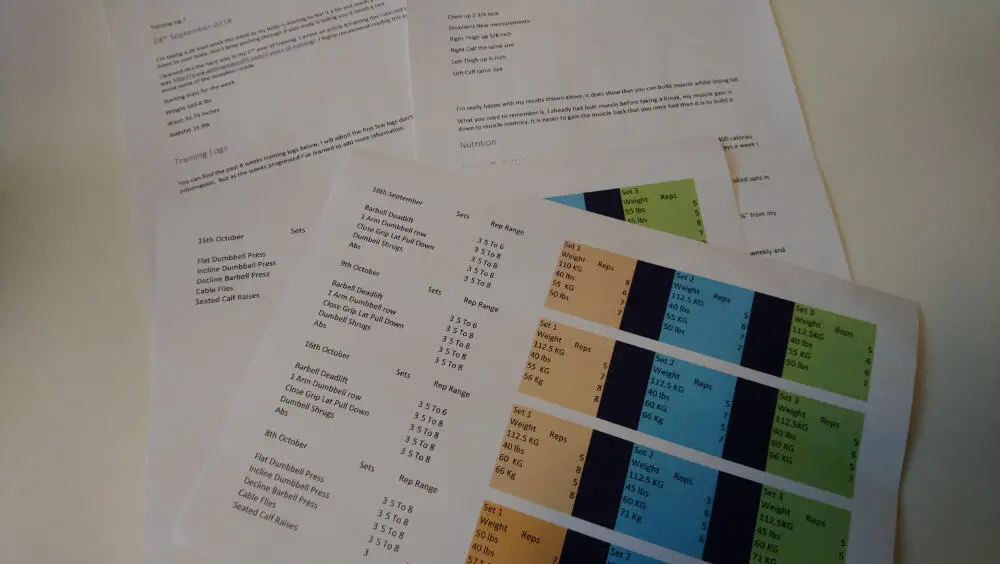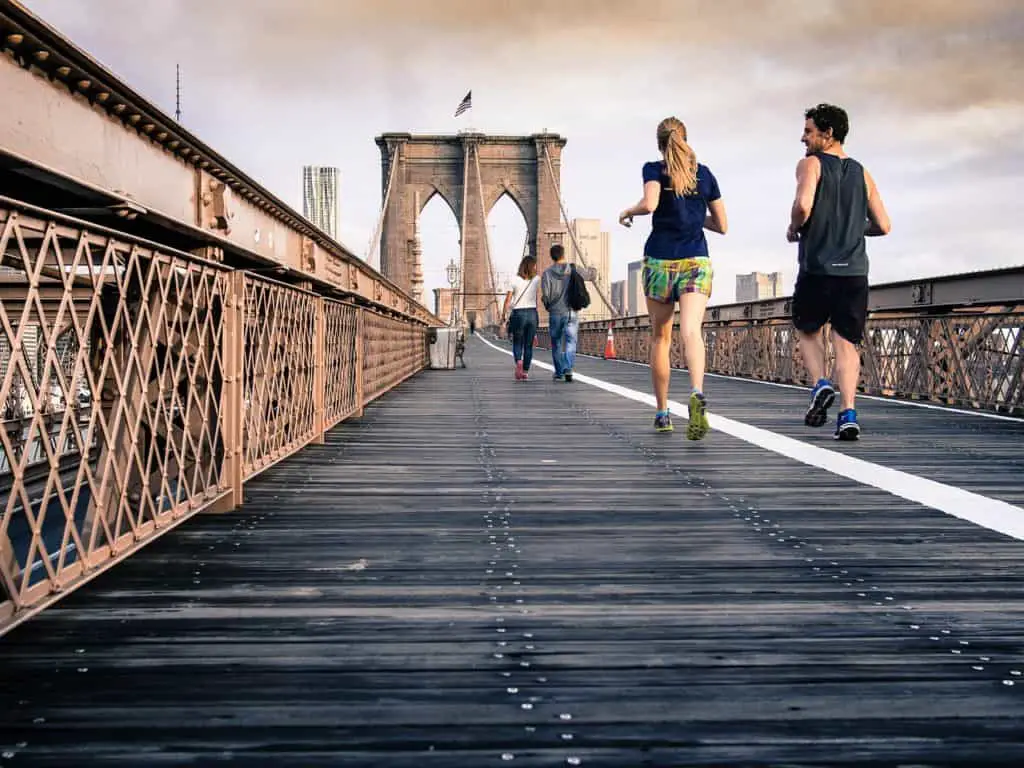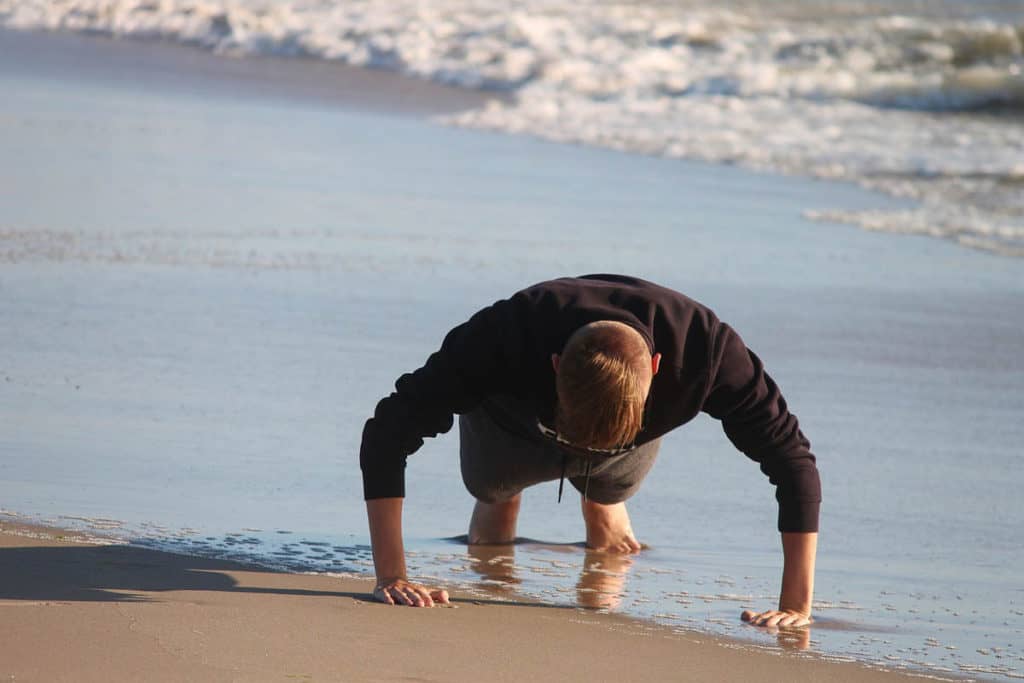Exercise becomes more important as we age. No one wants to hear that, though. Exercise is laborious, sweaty work, so, if you’re not an athlete, why even bother with exercising?
Although some people get into exercise for the wrong reasons (steroids, to intimidate others, vanity, etc.), there’s no question that it is the one surefire way to improve the quality of life. Exercise keeps your body in peak physical shape even as we grow older. And lest we forget, exercising has tremendous mental benefits too.
But what happens when your body starts to get too fragile for exercise? Some things, like aging, are beyond your control. We lose bone density with time and eventually become brittle and prone to fracturing. Some activities become too vigorous for them to handle. Does that mean that exercise is entirely off the table for you?
Is Resistance Training Good for Osteoporosis? Yes and no. Some exercises are far too strenuous and risky, especially if your bone density is not what it used to be. However, that doesn’t mean that you can’t rebuild your bone density as an older adult using exercise.
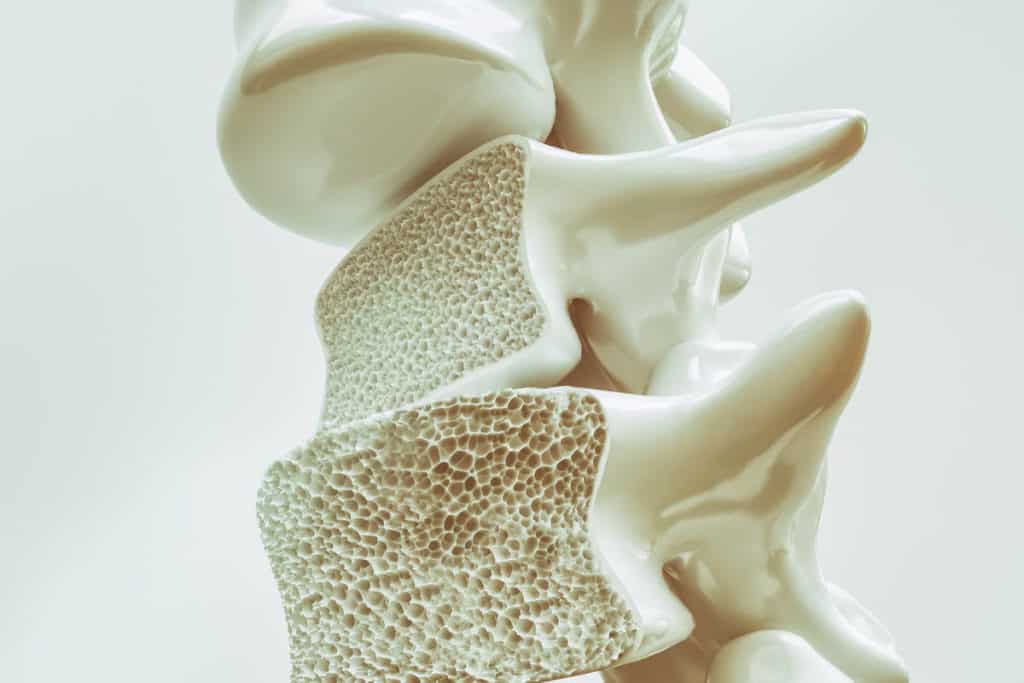
First, let’s look at what Osteoporosis is to understand the best exercises for people with weaker bones.
What is Osteoporosis?
Healthy bone tissue has tiny holes in it, much like a honeycomb or sponge. When Osteoporosis strikes, these holes increase in size, robbing the bone of both strength and density. After a while, bone tissue develops osteopenia, which is like a middle point. It makes the bones weaker, but not to the extent that they break easily.
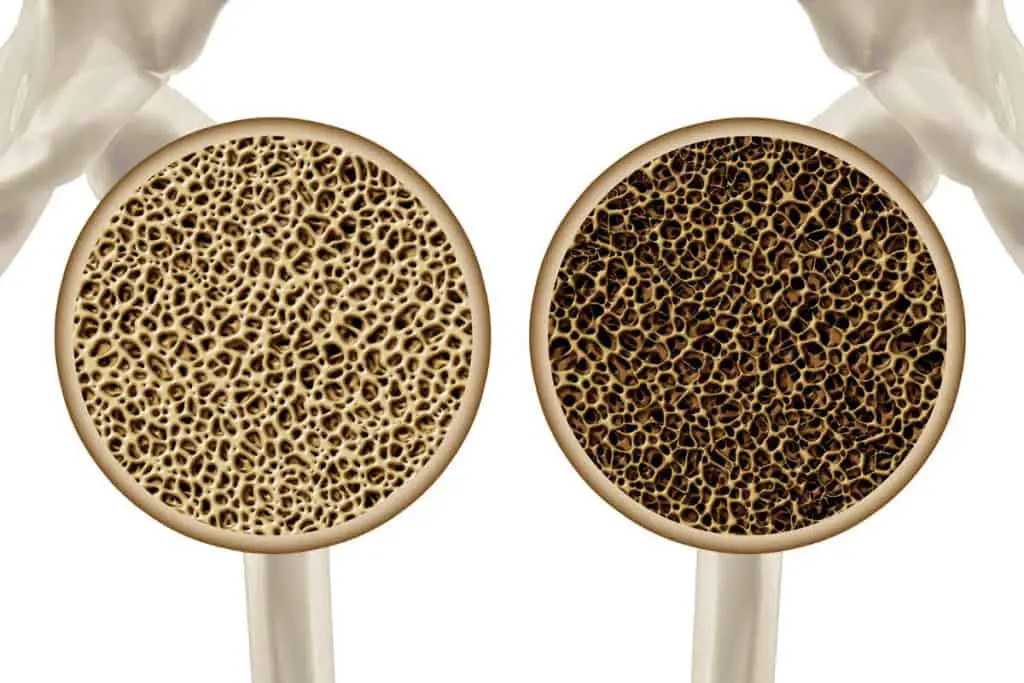
Gradually, the outside of the bone grows thinner and weaker, marking the onset of full-blown Osteoporosis. At this point, bones are prone to fractures.
People with Osteoporosis face a higher risk of getting fractures and broken bones during physical activities like walking and riding a bike. Although females are more susceptible to the condition, it can affect anyone regardless of age and gender.
Why Exercise is Good for Osteoporosis
Everyone knows that exercise is the single most effective way to lose weight and build muscle mass. What you might not know is that it increases bone density as well.
Like most things in the body, bones are living tissue. They respond to exercise the same way muscles do: by growing denser and more robust. Plus, exercise strengthens surrounding muscle tissue too. It improves coordination and balance, making you less likely to fall and break something. Chair Yoga or Tai Chi are excellent forms of exercise for improving your balance.
Health experts recommend exercise as one of the critical ways to increase bone mass and density. When you exercise, you build more than just muscle. Your bones increase in amount and thickness too. If you have Osteoporosis, Exercise can prevent your bone mass from deteriorating further.
It’s worth noting that only a specific type of exercise is suitable for Osteoporosis. Weak bones shouldn’t be under undue stress, which rules out anything that pushes you beyond your limit. Activities like swimming and cycling don’t do much for your bone density, although they do improve cardiovascular fitness.
The good news is, you can increase your bone mass (or at least maintain it) using the following exercises.
Exercises that Build Bone Density
Aerobic exercise, on its own, is not enough to build bone density. The year-long study conducted by scientists from Yale, Harvard, and Washington, yielded plenty of evidence to show that while good for the heart and lungs, exercises like walking and running can’t increase bone mass and density.
The right exercise, as it turns out, is a combination of small weight-bearing aerobic exercise and resistance training using free weights and resistance machines.
1. Resistance Training
Resistance exercise involves working against the weight of an object, building bone and muscle strength in the process, and increasing mass and density. Resistance training comes highly recommended by health experts as an exercise to restore or maintain bone density. It is one of the activities someone with Osteoporosis has to do to avoid breaking or fracturing their bones.
This exercise requires one of three types of equipment: free weights and resistance machines, resistance tubing of varying strength, or a water body (movements underwater make the bodywork harder than usual).
Good as it is for weakened bones, you shouldn’t work out the same muscle groups for two days in a row. Muscles need time to recover and grow, so schedule your resistance exercises two to three times a week. Work out every muscle group, including your arms, abdominals, back, and chest. Gradually make the training more challenging by increasing the number of repetitions or the weights you use.
2. Weight-Bearing Exercises
Any activity that involves supporting your body’s weight using your feet and legs is a weight-bearing exercise. It includes walking and hiking, dancing, and climbing stairs.
While it may seem like they belong in this category, swimming and cycling are not weight-bearing aerobic exercises. In both activities, something else supports your body weight (the bicycle, the water), so these exercises are only good for the heart and lungs, not Osteoporosis.
How much walking or hiking is necessary for good bone health? Experts recommend walking up to five miles a week for stronger bones, or working out vigorously five times a week for thirty to forty-five minutes each day. A fitness tracker will be able to help keep track of your steps and distance. For more information on fitness trackers, read the following article Do Fitness Trackers Really Help You? 11 Pros and Cons.
3. Balance and Flexibility Training
Your joints need to be flexible to provide full support to your bones. Therefore, flexibility is vital for preventing injury if you have Osteoporosis.
Some of the exercises you can do to increase your balance and flexibility are:
- T’ai Chi: An ancient art that promotes flexibility and balance. T’ai Chi is a low-impact form of exercise that helps build flexible joints and improve balance.
- Yoga: Yoga can be an intense form of exercise that strengthens joints and reinforces stability and balance. You can start with Chair Yoga. Chair yoga will also help with your balance.
- Stretches: Stretches benefit the muscles and joints by making them flexible and giving them room to expand. Make sure you don’t force yourself to overstretch and to cause an injury.
Types of Exercises for Osteoporosis
It’s time to get down to the nitty-gritty. The following is a list of exercises that are good for Osteoporosis.
1. Bicep Curls
Bicep curls need about 5 pounds of resistance to yield results. You can achieve this using either free weights or a resistance band. It doesn’t matter whether you do it sitting down or standing up. What matters is you use the correct form. If you don’t own a set of dumbells, you can purchase a set from Amazon.
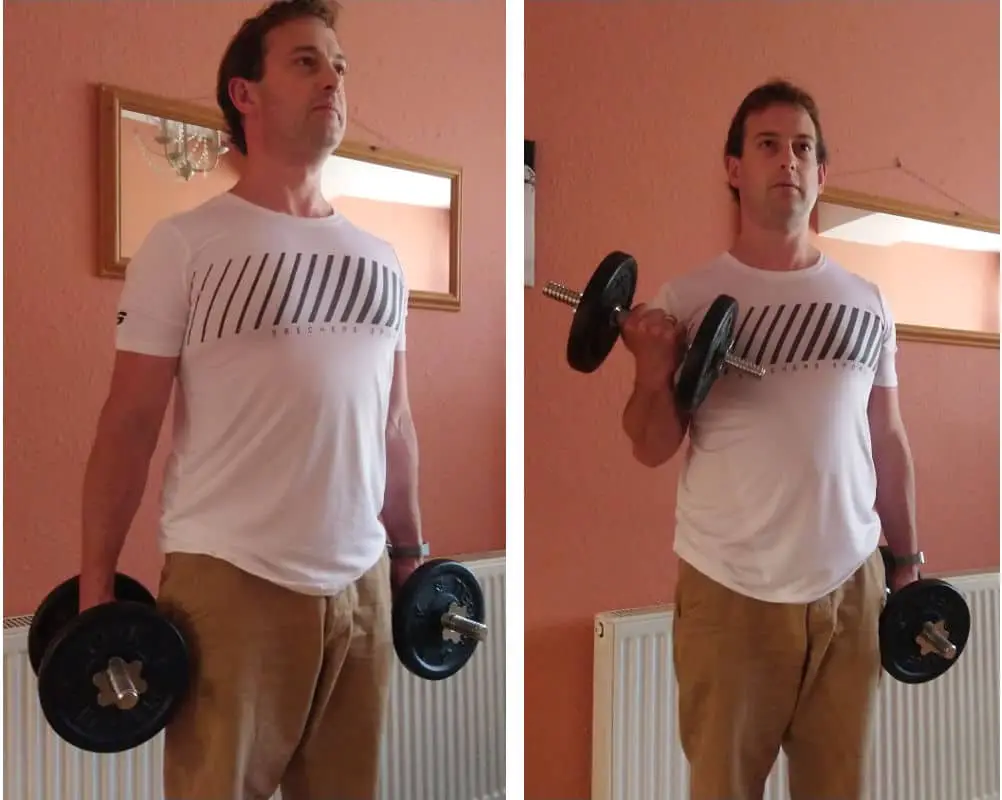
First, grab a dumbbell in each hand, or step on a resistance band and hold the ends in each hand.
Pull each weight or band towards your chest, contracting your biceps and the muscles in your forearm.
Return to the starting position (with your arms lowered) and repeat the exercise for the required number of reps. Rest for about a minute during each interval.
2. Hamstring Curls
Hamstring curls work on the muscles on the back of your upper leg. You can perform this exercise while standing. If you need to, place your hands on a heavy piece of furniture to stabilize yourself.
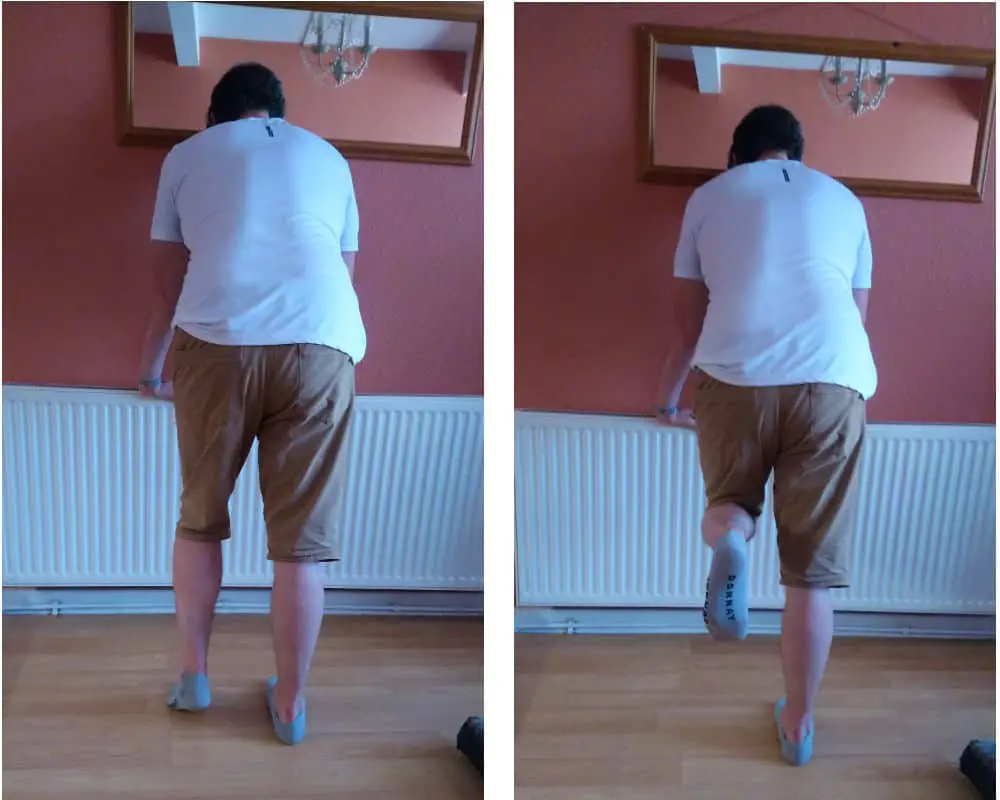
Place your feet shoulder-width apart. Starting with your left foot, draw back the heel until only the toes touch the floor. This pose is the starting position.
Slowly contract the muscles on the back of your upper legs (your hamstrings) to lift your foot towards your glutes (buttocks). Lift it as far as it will go then hold the position for a few seconds.
Lower your raised foot slowly back down until you’re back in the starting position.
Repeat the exercise with the other leg, then switch back. Do this as many times as you need to complete your set.
3. Ball Sit
The ball sit promotes balance and builds core strength. It focuses primarily on abdominal and lower back strength. You will need an exercise ball for this as well as a spotter to help you maintain your balance. If you don’t own a fitness ball, you can purchase one from Amazon.
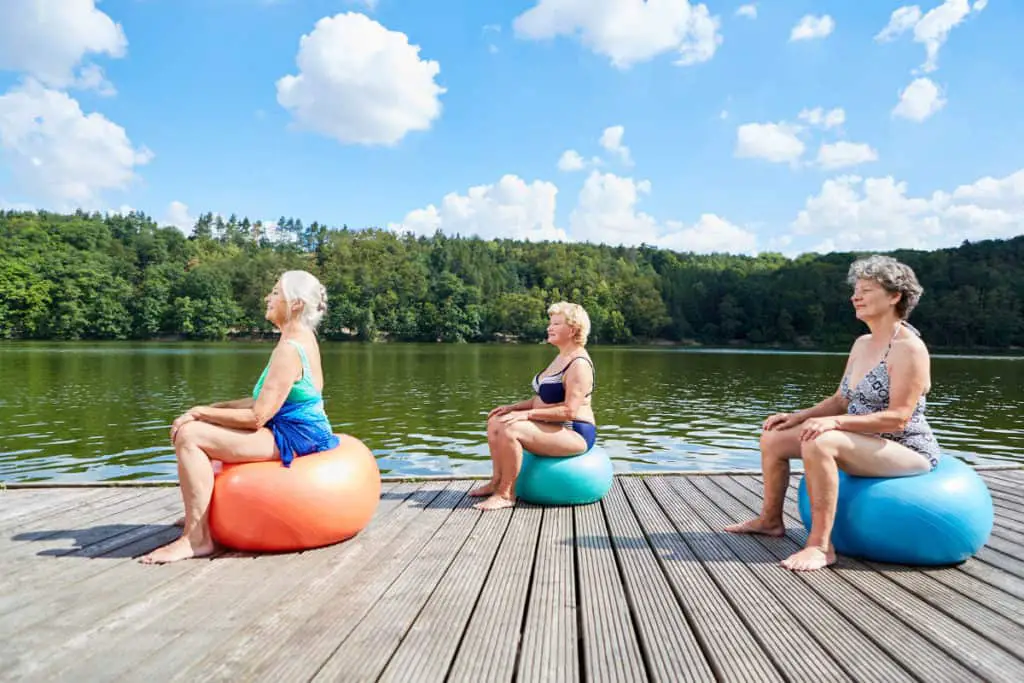
Sit on the ball with your feet flat on the floor. Your back should stay straight. Try to maintain your balance. If you can, hold out your hands with your palms facing forward.
Hold the position for as long as you can — a minute is as good as any duration — then stand up and rest. Repeat the process at least two more times.
4. Squats
Squats strengthen your glutes and the front of your legs. However, before it can have any effect, you need to squat deeply.

Start with your feet hip-width apart and rest your hands on some furniture or a tabletop for support.
Bend your knees to begin the squat. As you slowly squat down, keep your back straight and lean your upper body slightly forward.
Finish the squat when your thighs are parallel to the ground. Return to the starting position by first clenching your buttocks and using that momentum to stand. Repeat the exercise at least 12 times.
5. Foot Stomps
Foot stomps help prevent Osteoporosis in the hip bones. This exercise is easy, and you need to do it standing.
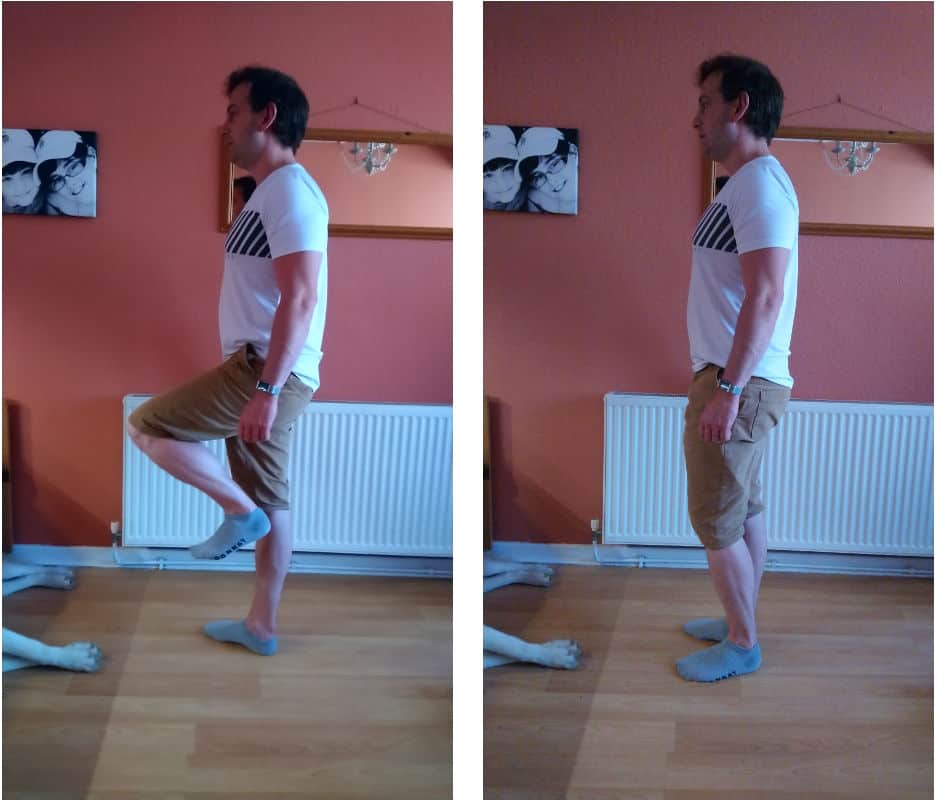
It goes like this: while standing, stomp your foot hard on the floor (as if you’re crushing this huge bug). Do it four times on one leg, then switch to the other leg. You may have to start off with soft stomps and build-up.
Hold on to something like a railing or piece of furniture while you do the exercise. You must stay balanced to avoid falling and hurting yourself.
6. One-Leg Stands
This exercise improves balance. All you need to do is find something stable to hold onto (could be a wall, a chair, railing, etc.).
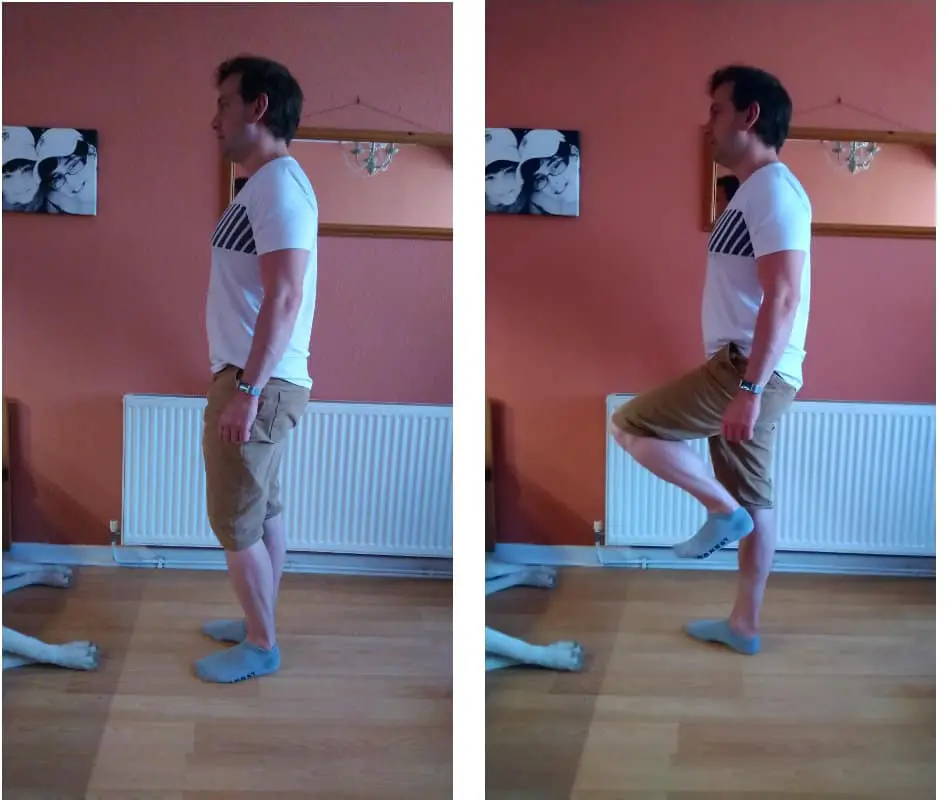
Stand on one leg for as long as a minute, then switch legs and repeat the exercise for the same duration.
7. Shoulder Lifts/Front Raises
You can do this exercise seated or standing, but you do need a resistance band or some free weights to execute it correctly. If you don’t own a set of dumbells, you can purchase a set from Amazon.
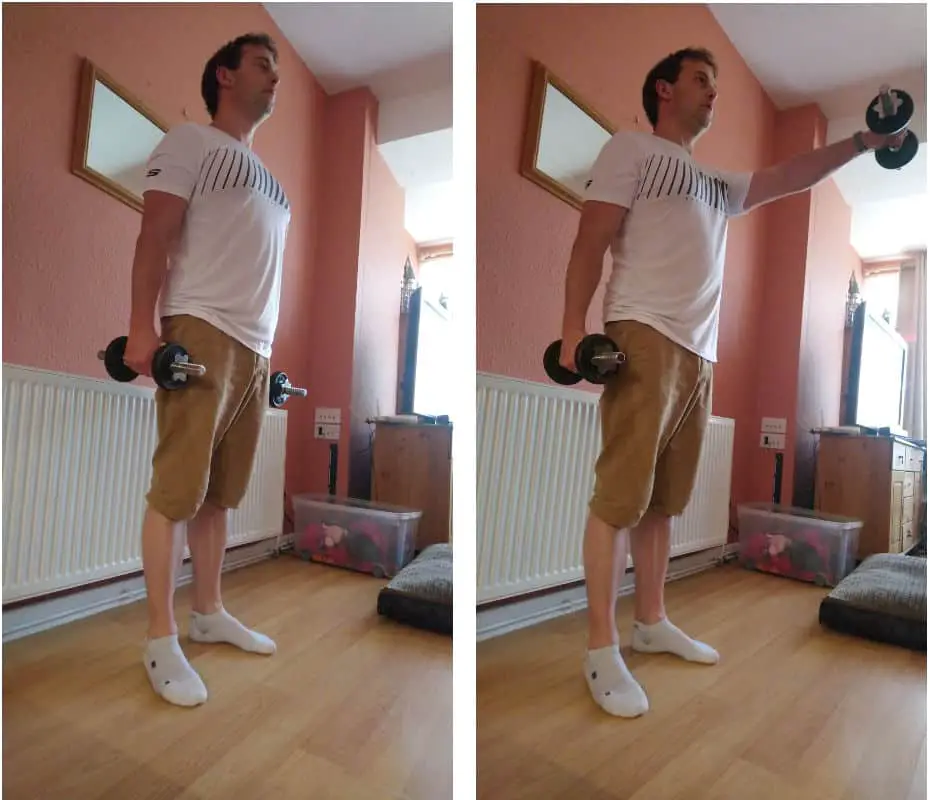
In the starting position, with a dumbbell or the end of a resistance band in each hand. Place your arms down by your side.
Raise your arms out in front of your body, but don’t lock your elbows. Make sure it’s your muscles in your shoulders doing all the work.
Lift as high as you can, but don’t go beyond shoulder height. Hold for a moment, then rest and repeat the exercise.
8. Hip Leg Lifts
Hip leg lifts help to strengthen the muscles around the hips and improve your balance. Steady yourself by placing your hands on a piece of heavy furniture.

First, put your feet hip-width apart, then shift your weight to your left leg. While keeping it straight, flex your right foot and lift your left leg to the side until it is about 6 inches off the ground. Hold the position, then lower it back down and repeat the exercise with the right leg. Do it at least 12 times.
The Most Effective Exercise Program for Bone Density
According to the Bone Estrogen Strength Training Study, an endeavor undertaken by scientists from the University of Arizona, the best exercise for Osteoporosis is a combination of weight-bearing exercise and resistance training.
With that in mind, it is possible to create an exercise template for Osteoporosis.
Stage One: 5 Minutes of Cardiovascular Warm-Up
To increase your endurance, it’s essential to perform some cardio exercises. Your heart and lungs will handle physical strain better when you train them.
Stage Two: 20 Minutes of Strength Training
These six core exercises should have six to eight reps per set. Perform at least two sets of each.
- Back extensions: Back extensions are performed on a 45° workout bench with anchored feet. Back extensions strengthen muscles in the lower back hamstrings, and glutes.
- Smith squats: Smith squats have a different effect because of the positioning of the feet. Unlike a barbell, using a Smith machine eliminates the need for balance so that you can move your feet out from under you at different angles.
- Seated row: Seated cable rows condition the muscles of the upper back; rear deltoids, rhomboids, traps, and lats. The exercise is most efficient when you use a cable stack.
- Leg press: By helping develop muscle hypertrophy, the leg press is an exercise that makes you better at performing other activities.
- Lat pulldown: The pulldown is an exercise that targets back muscles like the latissimus dorsi (lats).
- One-arm military press: This is another exercise that targets the upper back muscles. You’re probably catching on that shoulder strength is crucial for overall body strength and stability. The classic one-arm military press, which trains the shoulder and upper back, is vital for upper body strength.
Stage 3: 15 Minutes of Weight-Bearing Cardio
In this stage, you will use weights around your ankles and arms to perform weight-bearing activities like walking, going upstairs, and some light jogging. It consolidates your heart and lungs, but with enough weights, these exercises are enough to increase bone mass and density.
Stage 4: 5 Minutes of Abdominal Exercise
Your core, which is the bulk of your torso, is crucial for balance and stability. By training your abdominals, you strengthen all the muscles in your center. A strong core makes it easy for you to move and position your body at different angles. Abdominal exercises may include sit-ups, crunches, leg raises, rows, and planking.
Stage 5: 5 Minutes of Flexibility and Balance Exercise
You cannot overstate the importance of staying flexible and balanced when trying to rebuild or maintain bone density. When your bones get enough support from surrounding muscles and ligaments, they are more secure. You’re less likely to fall and injure yourself if you practice balance and stretch your muscles regularly.
Exercises You Should Avoid if You Have Osteoporosis
Exercise is undoubtedly good for Osteoporosis, especially resistance training and weight-bearing activities. However, some tasks will do more damage than good, so you should avoid them altogether.
What Exercises are These?
- Hiking may be in our list of appropriate weight-bearing exercises, but you have to think about the state of your bones. If you have Osteoporosis, the chances of getting injured from falling or hitting a rock are much higher if you hike regularly. It’s not that hiking is not suitable for Osteoporosis; the problem is that it is risky.
- Walking comes highly recommended for people with mild to moderate osteopenia. However, brittle bones should not be put under too much pressure as they fracture far too quickly. Keep your walking exercises at a minimum to avoid wearing out bones that are weak from Osteoporosis.
- Jogging is excellent for overall health and cardiovascular resilience. However, if you have severe Osteoporosis, consider other leg exercises before you jump straight into running. The trick is to ease into it until your legs are strong enough to run without causing injuries to yourself.
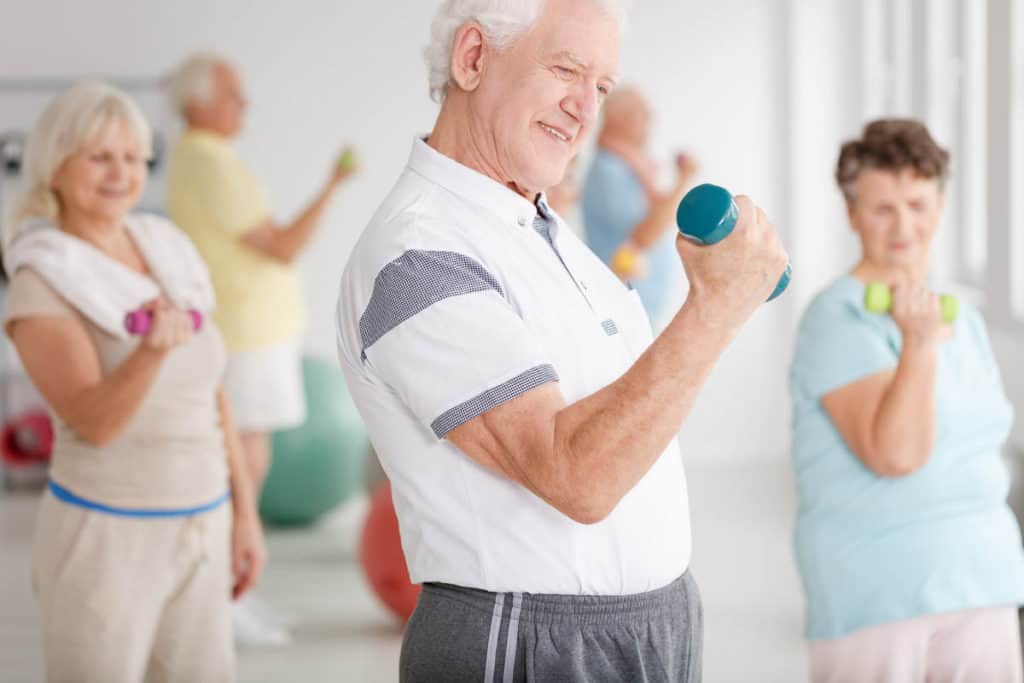
Resistance Training is Good for Osteoporosis
The best way to increase bone density is through resistance exercise. Using weights and resistance bands proves to be the best way to keep Osteoporosis at bay while maintaining an active lifestyle.
Remember that your diet is just as important. You may need calcium supplements to expedite the growth of your bone mass. Also, drink plenty of fluids and uphold a balanced diet to keep your body healthy enough for exercise.
Also, look at creating a meal plan to help start eating healthily. It’s easier to eat healthier if you plan your meals.

